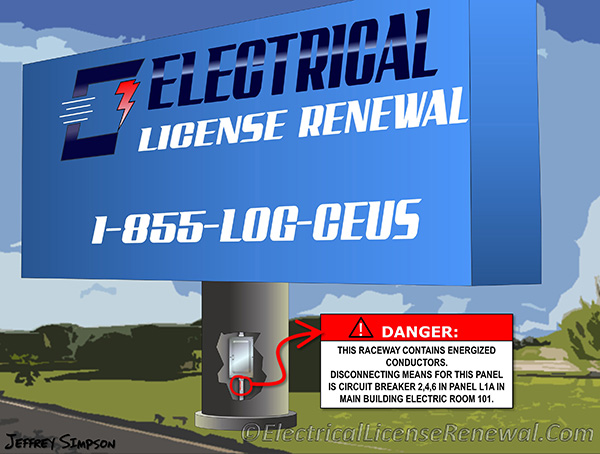600.6(A) Sign Disconnect Location.

Code Change Summary: A new exception was added to address large signs with internal panelboards.
Disconnect switches for signs provide a way for the sign electrician to kill power to the sign in order to perform maintenance. As stated in the informational note to 600.6, “the location of the disconnect is intended to allow service or maintenance personnel complete and local control of the disconnecting means”.
For the last two code cycles, changes have occurred to the requirements for sign disconnects. In the 2014 NEC®, it was made clear that a disconnect was required at the point where the feeder or branch circuit supplying a sign enters a sign enclosure or pole. In the 2017 NEC®, a proposal was accepted to allow an exception for large scale signs that are equipped with internal panelboards. Sometimes these large signs may have 400 amp or larger panelboards inside the sign body and it can be difficult to apply the previous code requirements to these large signs.
Now, a disconnect is not required at the point of entry to a sign enclosure for branch circuits or feeders that supply an internal panelboard inside a sign enclosure. The conductors must be enclosed in a Chapter 3 listed raceway or metal-jacketed cable identified for the location. As well, a field-applied permanent warning label that is visible during servicing must be applied to the raceway at or near the point of entry into the sign enclosure. The warning label must comply with 110.21(B) and state the following: “DANGER. THIS RACEWAY CONTAINS ENERGIZED CONDUCTORS.” The marking must include the location of the disconnecting means for the energized conductors and the disconnecting means must be capable of being locked in the open position in accordance with 110.25.
Below is a preview of the NEC®. See the actual NEC® text at NFPA.ORG for the complete code section. Once there, click on their link to free access to the 2017 NEC® edition of NFPA 70.
2014 Code Language:
600.6(A) Location.
(1) At Point of Entry to a Sign Enclosure. The disconnect shall be located at the point the feeder circuit or branch circuit(s) supplying a sign or outline lighting system enters a sign enclosure or a pole in accordance with 600.5(C)(3) and shall disconnect all wiring where it enters the enclosure of the sign or pole.
Exception: A disconnect shall not be required for branch or feeder circuits passing through the sign where enclosed in a Chapter 3 listed raceway.
2017 Code Language:
600.6(A) Location. The disconnecting means shall be permitted to be located in accordance with 600.6(A)(1), (A)(2), and (A)(3):
(1) At Point of Entry to a Sign. The disconnect shall be located at the point the feeder circuit or branch circuit(s) supplying a sign or outline lighting system enters a sign enclosure, a sign body, or a pole in accordance with 600.5(C)(3). The disconnect shall open all ungrounded conductors where it enters the enclosure of the sign or pole.
Exception No. 1: A disconnect shall not be required for branch circuit(s) or feeder conductor(s) passing through the sign where enclosed in a Chapter 3 listed raceway or metal-jacketed cable identified for the location.
Exception No. 2: A disconnect shall not be required at the point of entry to a sign enclosure or sign body for branch circuit(s) or feeder conductor(s) that supply an internal panelboard(s) in a sign enclosure or sign body. The conductors shall be enclosed in a Chapter 3 listed raceway or metal-jacketed cable identified for the location. A field-applied permanent warning label that is visible during servicing shall be applied to the raceway at or near the point of entry into the sign enclosure or sign body. The warning label shall comply with 110.21(B) and state the following: “Danger. This raceway contains energized conductors.” The marking shall include the location of the disconnecting means for the energized conductor(s). The disconnecting means shall be capable of being locked in the open position in accordance with 110.25.
See NEC® 600.6(A)(2 & 3) for additional changes.